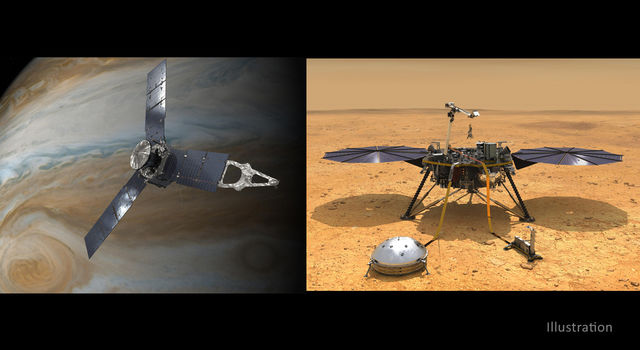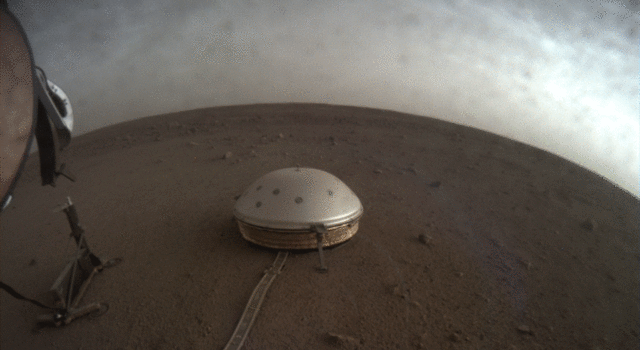Blogs | Dawn Journal | September 12, 2007
September 12, 2007
Dear Dawntastics,
Now less than two weeks from its planned September 26 launch, Dawn is eagerly awaiting the beginning of its fantastic adventure. It has been here before, but the opportunity to take the fast track out of Florida in June or July was consumed by delays in the readiness of the launch vehicle, adverse weather conditions, and problems with launch vehicle tracking facilities. After spending a very quiet, if not boring, 7 weeks at nearby Astrotech, the spacecraft returned to the launch pad on September 11.
While Dawn remains unwaveringly committed to its mission to explore Vesta and Ceres, the first part of the trajectory from Cape Canaveral’s Space Launch Complex 17B to the alien worlds is different for an autumn departure from what it would have been in the summer. Lacking an interplanetary version of mapquest.com, the Dawn team has developed a new route. It begins with a different launch profile, so right now -- at this very instant! -- you are reading an updated version of the June 23 log accounting for those changes. (The preceding sentence may not apply to readers capable of advanced time travel, but this sentence does -- or did -- or perhaps will.)
In addition to some changes in times, altitudes, and velocities, readers who have the details of the earlier version of this log committed to memory will notice that the mass of the third stage is different. As with most missions, the Dawn team finished designing the launch trajectory before the spacecraft was fully assembled. To ensure that the parameters loaded into the rocket’s guidance computer would be correct, engineers planned for the maximum possible spacecraft mass. As explained at the beginning of the log we are updating, when Dawn was tested for its stability at 50 rpm, it was better balanced than had been expected. That meant it was not necessary to add as much mass to it as had been considered possible, so Dawn’s final mass was less than anticipated. By then, it would have been too time consuming to update the Delta’s computer parameters, so ballast masses were installed on the third stage. This brought the combined third stage and spacecraft mass to the value used in all the trajectory calculations.
With the delay in the launch and the need to redesign the guidance program for the different launch conditions anyway, engineers were able to take advantage of their knowledge of the final spacecraft mass. So the 5.34 kg (11 pounds 12 ounces) of ballast were removed from the third stage, and the new plan benefits a little from the lower mass by commanding the rocket to impart slightly more energy to the spacecraft.
With that background, now that launch is so close, let’s have a preview of what is planned during this important event. Much of the work on the design of the spacecraft focused on ensuring that it is prepared for the acceleration, vibration, noise, heat and cold, and other conditions it will experience during the ride to space. And yet for all that effort, as well as the spectacular sights and sounds for observers, this is the shortest phase of the mission. During it, Dawn will be a polite passenger, patiently recording data and awaiting its chance to begin flying on its own in space to undertake its mission of discovery deep in the solar system.
This log has many more numbers (readers are encouraged to quantify this) than most, and hence will be of special interest to our friends the Numerivores, who reside in the “quadruple quasar” Q2237+0305. Others need only follow well enough to gain a sense of how dynamic Dawn’s departure from home will be, in great contrast to the more leisurely pace of its interplanetary flight.
In a previous log, we saw that to leave the launch pad, the Delta rocket will use its liquid-fueled first stage and 6 of the 9 solid rockets strapped to its side. Thirty seconds later (L + 30 seconds) it will exceed the speed of sound. The solid motors burn out at about L + 77 seconds when the rocket is at an altitude of about 24 kilometers (15 miles), and the remaining 3 motors ignite less than 2 seconds later. Three of the spent motors separate at L + 80.5 seconds, and the other 3 are jettisoned 1 second later as the rocket continues its ascent. The remaining 3 motors burn for 77 seconds, and when they are released at L + 2 minutes 39.5 seconds, the rocket will be nearly 73 kilometers (117 miles) high and traveling 10 times the speed of sound. The first stage’s main engine continues firing on its own until L + 4 minutes 23 seconds, and then the rocket coasts for 14 seconds. After 8.5 seconds of the coast, having lofted Dawn to 130 kilometers (81 miles), the first stage separates.
When the second stage engine is commanded to life 5.5 seconds later, the rocket is traveling at 6.1 kilometers per second (3.8 miles per second, or almost 14,000 miles per hour). At an altitude of 135 kilometers (84 miles), the shroud that shielded Dawn from the dense atmosphere below is no longer needed, so it is ejected. Now 4 minutes 41 seconds from liftoff, Dawn has its first view of space. The second stage continues climbing and accelerating until it reaches the altitude and velocity to be in a low orbit. At L + 8 minutes 58 seconds, the stage stops firing.
Let’s take advantage of the hiatus in orbit to consider the timing of all the events during launch. The overwhelming majority of spacecraft our species [Note to extraterrestrial editors who repost these reports: change the previous two words to “humankind.”] sends beyond the atmosphere remain gravitationally tied to Earth. They accompany the planet on its endlessly repetitive travels around the Sun, and except for the few that are designed for scientific observations of the cosmos, the orbits of these satellites are mostly unrelated to the rest of the solar system. Where Earth is in its orbit, and where other members of the Sun’s retinue are, generally do not matter. Such is not the case for Dawn (and other interplanetary probes).
The entire launch sequence is timed so that Dawn will depart Earth at a carefully chosen point in the solar system. For each possible launch day, extensive analysis has established the mathematically optimal plan for reaching Vesta and Ceres, distant worlds that beckon and that Dawn seeks to unveil. The analyses account for the gravitational effects of the Sun and all planets, and the resulting strategies (modified somewhat from the mathematically perfect solutions) include times that Dawn will thrust with its ion propulsion system and times that it will coast. As reported in another log, many years of exquisitely gentle thrusting allows the indefatigably patient probe to reshape its orbit around the Sun to rendezvous with its destinations. As we will see in logs after launch, the first 80 days of the mission will be devoted to checking out the spacecraft systems and preparing for the long journey ahead. At L + 80 days, the thrusting needed to follow the flight plan begins, and the timing of the launch sequence is arranged so that Dawn will be at the correct location in the solar system, about 27 million kilometers (17 million miles) from Earth, at that time.
The second and third stages linger in Earth orbit so that following the ascent from Cape Canaveral, they are properly positioned to propel Dawn to reach its required location nearly 3 months later. If launch occurs before October 10, the pause in the second stage’s firing will last about 42 minutes 37 seconds. (Because the solar system is constantly rearranging itself, launches near the end of the launch period will slightly require longer intervals. Maintaining a constant interval for most of the launch period is a degree of flexibility enabled by the ion propulsion system and was chosen to reduce the vast volume of work required to design the autumn launch trajectories in the short time available.)
Had the launch occurred in June or July, Dawn would have departed in a very different direction, which would have been reached with a much shorter pause in Earth orbit. To deliver its precious payload to the new starting point for the interplanetary journey, the Delta rocket now needs 33 minutes 30 seconds longer to travel from the launch pad to its target than it would have on July 8. To keep its temperature comfortable during this extra time, the rocket performs a “barbecue roll,” allowing all parts to receive equal exposure to the hot Sun, warm Earth, and cold space. After turning to the programmed orientation, the second stage begins rolling at the lazy rate of 1 revolution every 6 minutes. During the 29 minutes 50 seconds of barbecuing, Dawn basks in the beautiful glow of its home planet for the last time. These are some of the final quiet moments before it goes to work on a journey of nearly 8 years and 5.1 billion kilometers (3.2 billion miles).
The second stage engine reignites at L + 51 minutes 35 seconds while at an altitude of 179 kilometers (111 miles) and operates for 2 minutes 39 seconds. Fifty seconds later, to finish its contribution to Dawn’s mission, the second stage fires 4 small rockets pointed around its circumference to spin the third stage and spacecraft to 48 rpm. (Unlike the first and second stages, the third stage is stabilized by gyroscopic rotation, like a spinning bullet or football.) This is when the spacecraft’s balance becomes most important. The second stage separates at L + 55 minutes 8 seconds.
For the next 37 seconds, the spinning assembly continues following the orbit the second stage left it in, and then the final burn of the Delta begins. The third stage fires for 86 seconds, and during that time it exceeds “escape velocity” so that it has enough energy to break free of Earth’s gravitational hold. When the solid motor burns out, it is only at an altitude of 275 kilometers (171 miles), but Earth is too weak to slow the rapidly receding craft enough to bring it back. (Pause here for a moment of awe: 80 days later, the spacecraft will be about 100 thousand times farther from Earth.) Unlike a ball you might throw that goes up and then comes down, the Delta will have thrown Dawn so hard that it will never fall down. It will be in its own orbit around the Sun, traveling at 11.46 kilometers per second (7.12 miles per second, or 25,600 miles per hour) relative to Earth. With the third stage spent, for the rest of the mission, onboard propulsion will be achieved only with ions.
When the second stage spins the spacecraft, the xenon propellant stored inside does not immediately spin up to 48 rpm, just as when you rotate a glass filled with a liquid, it takes a while for the liquid to catch up with its container. (We recognize that some readers live on planets without liquids, but the analogy applies to gases as well. In fact, the xenon on Dawn is maintained at a temperature and pressure that create a special state called “supercritical,” in which it bears some similarity to a gas and some to a liquid. Amazing though its properties are, supercritical xenon should not be confused with superheroes that may bear similar names.) The friction between the rapidly spinning spacecraft and the xenon inside it causes the spacecraft’s spin to slow down and the xenon’s spin rate to grow. The Dawn project has invested a great deal of effort over the past 2 years to understand the detailed behavior of the xenon while the spacecraft is spinning. This has involved both sophisticated analysis techniques as well as spin tests with a tank of exactly the same shape and size as Dawn’s filled with a fluid with properties similar to those of xenon’s. Based on this work, engineers can predict how quickly the spacecraft and xenon will change each other’s spin rates.
After the third stage has finished firing, it remains securely attached to Dawn for another 4 minutes 50 seconds. Although the stage is stabilized by spinning, the spacecraft does not operate that way; yet by this time, they would be spinning together at 46 rpm, too fast for the latter’s control system. Therefore, starting 5 seconds before separation, the third stage activates a surprisingly simple system to slow its rotation rate. Wrapped around the Delta are two cables, each 12.15 meters (39 feet 10 inches) long. At the end of each is a 1.44-kilogram (3-pound-3-ounce) weight made of aluminum and tungsten. When the cables are released, the spin causes them to unwind. As they carry the weights farther and farther out, the spin slows down because of the same principle that makes an ice skater spin faster by pulling her arms in or slower by extending them to her sides. After 4 seconds, when they are fully unwound, the cables unhook from the spacecraft. With their weights still attached, they enter independent orbits around the Sun; perhaps one of them will be studied by a future solar system archeologist.
The values of these “yo-yo” weights are chosen carefully and are accurate to about 1 gram (0.04 ounces) in order to achieve the required change in spin rate. The slight reduction in mass of the third stage because of the removal of ballast required a tiny change in the yo weights. Eschewing both diet and exercise, technicians opted for surgical removal of 7 grams (0.2 ounces) from each one.
Even with a 204-kilogram (450-pound) third stage (which was 2224 kilograms, or 4903 pounds, before it began expending its propellant) and a 1218-kilogram (2685-pound) spacecraft, the small yo-yo system halts the spin and even reverses it, leaving Dawn rotating at 3 rpm in the opposite direction from its original spin. About 1 second after the cables have separated, the attachment between Dawn and its rocket is severed, and springs push them apart.
Only 62 minutes 1 second after liftoff, while 1021 kilometers (635 miles) above their home world, the Delta bids the spacecraft farewell. The third stage, its raison d'être fulfilled and having no further purpose, continues on its own through the vast emptiness of the solar system. But its disconnection from Dawn triggers sensors on the spacecraft that alert the central computer to the separation.
Spinning slowly at 3 rpm in one direction, with xenon inside spinning at 39 rpm in the opposite -- the original -- direction (because the propellant still lags behind its container), Dawn waits for 8 minutes 20 seconds. That is long enough for the spacecraft and xenon each to slow the other down, and after that, Dawn’s systems are ready to go to work.
In the next log, shortly before launch, we will see what the spacecraft plans to do as mission control waits to hear from it. That update of the July 5 log also will have a special suggestion for our readers in Hawaii, Alaska, and near the Pleiades on how to catch Dawn’s early light less than 2 hours after liftoff.
Dr. Marc D. Rayman
September 12, 2007
TAGS:DAWN, VESTA, CERES, DWARF PLANET, MISSION, SPACECRAFT







